Mon 14 Jul 2014
Reviewed by Jonathan Lewis: DAVID DODGE – Plunder of the Sun (Book/Film).
Posted by Steve under Action Adventure movies , Reviews[12] Comments
DAVID DODGE – Plunder of the Sun. Random House, hardcover, 1949. Paperback reprints: Dell #478, 1951, mapback edition; Hard Case Crime, 2005.
PLUNDER OF THE SUN. Warner Brothers, 1953. Glenn Ford (Al Colby), Diana Lynn, Patricia Medina, Francis L. Sullivan, Sean McClory. Screenplay: Jonathan Latimer, based on the book by David Dodge. Director: John Farrow.
Sometimes, it’s a whole lot of fun to plunge into an adventure story, replete with intrigue, shady characters, and historical references to ancient civilizations. And gold. Sadly, stories with plots focusing on the search for treasure in exotic locales are not written very much anymore. Perhaps they are considered passé; perhaps there just aren’t enough contemporary readers for these yarns.
But if this type of fictional adventure does happen appeal to you, you really can’t go wrong with Plunder of the Sun. Written by David Dodge, author of To Catch a Thief, the story follows the South American treasure seeking adventures of American expatriate Al Colby, our first person narrator. It’s both a fun little suspense tale and an introductory course in Peruvian geography and history.
The book’s opening places the reader right into the heart of the action. The story’s narrator, Al Colby, is in Santiago, Chile, where he meets up with Alfredo Berrien, a sickly man in a wheelchair, and his nurse, Ana Luz. Berrien has a proposition for Colby. He wants him to transport a small package on board a ship heading from ValparaÃso, Chile to Callao, the Peruvian seaport. Once there, Colby is supposed to return the package to Berrien and to get paid.
As you might imagine, things don’t go quite as planned. After a series of potentially sinister characters show up on board the ship, Berrien is found dead in his cabin. Naturally, Colby becomes curious as to what’s in the package. Turns out it contains parchment fragments that tell, you guessed it, of buried treasure.
The rest of the novel follows Colby in his quest to decipher the manuscript and to deal with a scheming man from the boat named Jeff. He also runs across Naharro, a Peruvian expert in antiquities, and his son, Raul. There’s also Julie, who was originally also on the boat and manages to be around at both the wrong and right times. There’s plenty of scheming afoot, a deal made, and a double cross. Plus Colby may or may not have feelings for Ana Luz.
Al Colby’s an interesting character, but the real star of the show is Peru. Dodge clearly knew the country well. His descriptions of the places, the people, and the culture all give Plunder of the Sun an authenticity that many other adventure tales from the era lack. There are numerous references to Incan history, particularly the Spanish conquest of Peru. The work is also filled with what I presume to be Peruvian-dialect Spanish.
Given how central Peru is to the book’s plot, I was skeptical when I learned that the film adaptation, directed by John Farrow, was set in Oaxaca. I expected just another adventure film set in Mexico. I was both pleasantly surprised and somewhat disappointed.
There is no doubt that Glenn Ford was well cast as Al Colby. He’s a good actor and he plays the role convincingly. Likewise, Patricia Medina portrays Ana Luz well. Sean McClory portrays the villain, Jeff, as Jefferson, a serpentine creep who slithers his way in and out of Colby’s presence.
Setting the film in Oaxaca rather than in Peru allowed the filmmakers to shoot on location. Turns out that was a great decision. There are some amazing visuals in the film, managing to give the viewer a glimpse into the ruins without making the film seem like a documentary.
And although it’s not a film noir, at times Plunder of the Sun does feel like one. There’s a claustrophobic aspect to the film, particularly in the first half. This is notably the case when Colby (Ford) first meets the wheelchair bound Berrien (Francis L. Sullivan). One wishes that Sullivan’s character didn’t have to die so quickly, for he seemed to be one of the more intriguing personalities in the story.
The problem is this. After a great setup, the story just kind of plods along, notably during the second half of the film. Colby and Jefferson fight, they make up, they fight again. It all just gets a bit tedious. Indeed, without the on-location setting, the film really wouldn’t be particularly interesting.
As it is, the book tells a much more fascinating story than the movie manages to tell. The film adaptation of Dodge’s work, despite a screenplay by veteran mystery writer Jonathan Latimer, somehow comes across as being both rushed and somewhat dull, turning what could have been a very good movie into a slightly above average adventure film. The film tells Colby’s story in what are supposed to be flashbacks or reminiscences. It’s a narrative technique that doesn’t quite work in this context, giving the movie less a sense of immediacy than the book.
In conclusion, David Dodge’s Plunder of the Sun is a fun, engaging read. It’s steeped in Peruvian geography and history, with well-developed characters, and enough mystery and intrigue to keep one guessing as to what is going to happen next.
While the film version isn’t bad, it does come across as something of a missed opportunity. The Oaxaca scenery does, however, almost makes up for the fact that the screenplay isn’t as strong as it could have been. Almost.

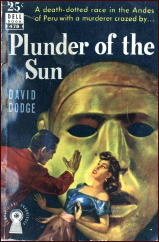
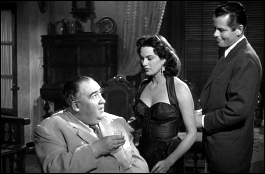
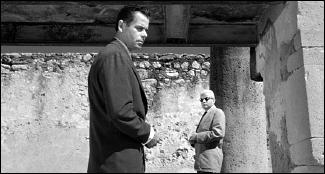
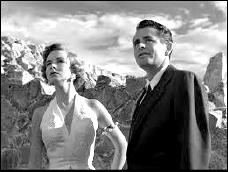
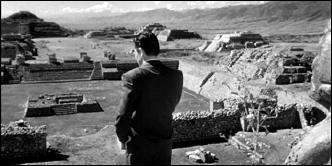
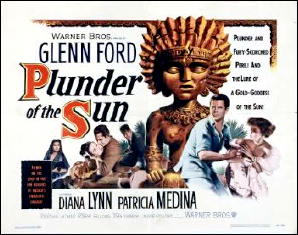
July 14th, 2014 at 9:44 pm
I am quite familiar with the film and its story telling problems, some of which, and I am unable to parse the finished product, stem from conflict between Ford and director Farrow. John Wayne essentially produced the film and Ford was scheduled to perform in a follow up feature western called Hondo — which turned out well. However, John Farrow was also set to direct, which he did, and Ford walked away. John Wayne took the lead himself and Hondo went on to great success.
July 15th, 2014 at 12:00 am
I think everyone was having too much fun on this one, it fizzles out a bit once the tequila sets in.
Colby also appears in The Long Escape also set south of the border.
Dodge was a travel writer as well as suspense novelist, and did two other series, one with ‘Whit’ Whitney a CPA sleuth and another with John Lincoln an American Secret Service agent. My preference is for his stand alones like To Catch a Thief and The Red Tassel. He is one of the most underrated suspense novelist of his era with intelligent plots, exciting action, exotic locales, and bit of an edge to most of his works, His characters tend to be well drawn, rounded out, and more deeply drawn than needed for thrillers.
I know a former mining engineer who says he carried his battered David Dodge paperbacks with him from the Western Desert of Australia to the mountains of Africa. That’s as good a review as a thriller writer can get.
Dodge’s travel books tended to be humorous and often featured travelling with his family.
If I remember right this was Irish actor Sean McClory’s American second film, I think his first the Wayne produced Ring of Fear with Mickey Spillane.
July 15th, 2014 at 12:46 am
In 2011, I believe, Hard Case Crime published Dodge’s “The Last Match.” I own it, but haven’t read it yet. Should probably get on that
July 15th, 2014 at 6:57 am
I read this one last year and, like Jonathan, enjoyed it for the Peruvian setting. I also have THE LAST MATCH, unread so far.
July 15th, 2014 at 7:17 am
I read THE LAST MATCH when Hard Case published it and liked it a good bit.
July 15th, 2014 at 8:44 am
Thank you for this fine review of an author I’ve yet to read, and a movie I’ve yet to see, although I would opine that the death notice for this style of adventure story, as suggested in the first paragraph of Jonathan’s review, is premature. For starters, try INCA GOLD by Clive Cussler. As for me, I’m off to find me some David Dodge!
July 15th, 2014 at 10:28 am
Sean McClory:
A great actor initially seen in The Quiet Man, which while filmed in Ireland, must be considered an American picture…Yes, David?
July 15th, 2014 at 10:51 am
I will have to look for Inca Gold (the book, although some real Au would be nice as well!)
McClory was quite good in this. You can tell he’s a very good actor just from his portrayal of Jefferson.
I should have discussed Francis L Sullivan more. He was great in this as well. In the book, Colby as narrator mentions that Berrien seemed Central European, but there’s no further development of this idea of his
July 15th, 2014 at 2:34 pm
Barry, split the difference, made in America. Yes, I remember him from The Quiet Man, and later a little bit of everything. He’s in Wellman’s Island in the Sky as well.
The DVD with Ring of Fear and Plunder in the Sun had a nice little piece on him as an extra.
Jonathan, almost all Cussler’s books are treasure hunts of one kind or another. The Fargo series by Thomas Perry especially well written treasure hunt tales. James Rollins books, especially the Sigma Force, always have some potent Indiana Jones type relic at the end of the rainbow.
In fact there is a whole genre of these out there currently, most involving treasure. I recommend Steve Berry highly, certainly his first about the lost Amber Room.
For a list of some of Cussler’s treaures.
Treasure — the Library of Alexandria
Sahara — a Confederate ironclad filled with gold
Cyclops — El Dorado
Atlantis Found — obvious
Valhalla Rising — the real Nautilus
Treasure of Khan — the grave of Ghengis Khan — also used in James Rollins the Eye of God along with the tomb of Attila the Hun.
Sullivan inherited the Sidney Greenstreet mantle to some extent though he was usually crueler on screen. I think my favorite is Caribbean with John Payne, Arlene Dahl, and Sir Cedric Hardwicke (as a pirate no less). He also played Dennis Wheatley’s Duc de Richielu in Forbidden Territory based on the first book in that series and was one of the Four Just Men in the British film of that book (The Secret Four).
I always thought he would have made a good Nero Wolfe myself.
July 15th, 2014 at 9:55 pm
Ideally I would have read the novel Plunder in the Sun or have seen the movie Plunder in the Sun so I could comment intelligently. However I am going to ignore Abraham Lincoln’s advice that it is “better to remain silent and be thought a fool than to speak out and remove all doubt,†and comment anyways.
When I lived in Mexico, I was in the city of Oaxaca, Oaxaca for about a week. A creative imagination could cast Oaxaca as a sinister place but I would not put it at the top of my list if I were looking for a noir setting in Mexico. The city’s clustered Colonial center reminds me more of the 1950s Havana from Our Man in Havana.
The ruins at Monte Alban, which seem to be the ruins in the photograph accompanying the article, have a stark feel that would fit well with 1950s sharp black-and-white cinematography. The feeling I got from them was not as intense or intimate that I have gotten from other ruins. In this film that explores the psychological landscape, perhaps it is better that the setting does not overshadow the characters.
July 16th, 2014 at 1:41 am
Daryl,
Thanks for your comments. It’s always interesting to hear from people who have visited the on location setting first hand.
Incidentally, the first 15 minutes of the film are supposedly set in Havana, Cuba, although I believe they were actually shot in Mexico as well. There definitely is an early 1950s Havana/Mexico City, as I understand it, feel to the movie. It works well enough for a crime film, which is what this essentially is.
In fact, if a screenwriter wanted to take liberties with the Dodge book, he could easily turn this into a quasi- Cold War-era thriller
July 17th, 2014 at 9:53 am
This film is in a dvd box set I have of 4 films produced by John Wayne’s production company that Wayne doesn’t appear in. McClory plays the villain in another of the films RING OF FEAR which has Mickey Spillane playing himself investigating mishaps plaguing the Clyde Beatty Circus. McClory also has a major role in THEM!.